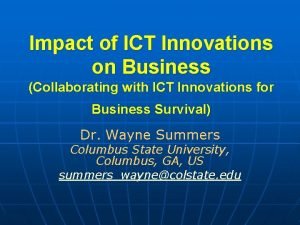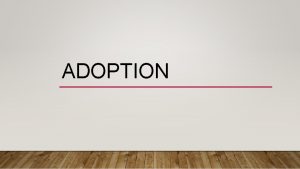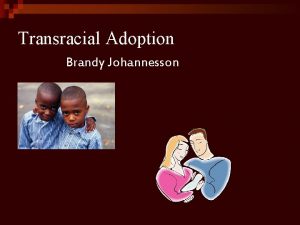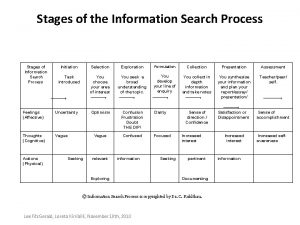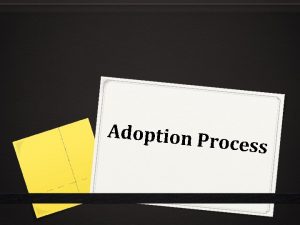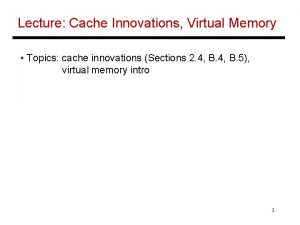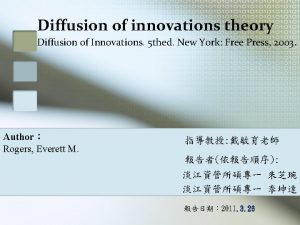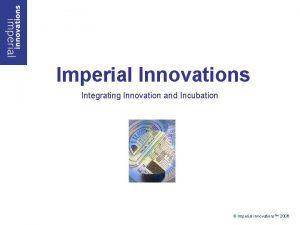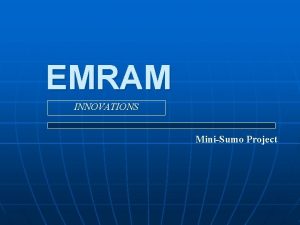STAGES IN THE ADOPTION PROCESS Adoption of innovations














- Slides: 14

STAGES IN THE ADOPTION PROCESS Adoption of innovations does not happen overnight, but rather goes through a series of steps. The adoption model was built heavily on normative theories about decision making models

Awareness Interest Evaluation Trial Adoption/ acceptance/ rejection It is important to note that people required and searched for different kinds of information during each stage

The information required evolved from: 1. information clarifying the existence of tensions and problems addressed by the innovation or policy measure 2. information about the availability of promising solutions 3. information about relative advantages and disadvantages of alternative solutions

4. feedback information from one’s own or other people’s practical experiences and 5. information reinforcing the adoption decision made.

Rogers (1995) proposed different stages in the adoption of innovations which are less inspired by normative decision making theory, and supposedly reflect better what happens in practice.

Knowledge Persuasion Decision Implementation confirmation

Research shows that not everyone adopts an innovation at the same time. On the basis of adoption index, researchers classified people into five different categories:

Innovators Early adopters Early majority Late majority Laggards 2. 5 % 13. 5% 34% 16. 0%

Diffusion refers to the spreading of innovations in a community. Studies in diffusion suggests that specific people in a community play an important role in stimulating or preventing the spreading of innovations. Such people are referred to as opinion leaders.

• • • Opinion leaders are people who are influential in shaping opinions of various kinds. Note that different people may be opinion leaders on distinct matters and for different groups of people. Others who may serve as ‘experiential experts’ may be influential in shaping people’s norms and values, or may play a role in legitimizing or disapproving particular changes

• • Diffusion research has shown that opinion leaders tend: To adopt many innovations, but usually are not the first to adopt them To be well educated and enjoy sound financial positions in their communities To lead an active social life and have many contacts outside their immediate surroundings.

• • • To have a special interest in a particular subject. On this basis, communication workers would be most effective if they target their activities at these opinion leaders. Focusing on ‘innovators’ or ‘progressive’ farmers in a particular community would mean other farmers would benefit almost automatically.

• The variables that determine the rate of adoption on innovations are: 1. Perceived attributes comprising: • Relative advantage • Compatibility • Complexity • Triability and • Observability.

2. Type of innovation decision: Optional Collective Authority 3. Communicative channels 4. Nature of the social system 5. Extent of change agent’s promotion efforts
 What innovations did the bessemer process encourage
What innovations did the bessemer process encourage Russian empire 1450 to 1750
Russian empire 1450 to 1750 Suny downstate new innovations
Suny downstate new innovations New-innov
New-innov Lucent technologies chip
Lucent technologies chip Innovations foresight
Innovations foresight Ict innovations for business
Ict innovations for business Lesson 4 cultural innovations
Lesson 4 cultural innovations Why was polo a popular sport among wealthy muslims?
Why was polo a popular sport among wealthy muslims? New innovations duty hours
New innovations duty hours Next level innovations
Next level innovations Marketing real people real decisions
Marketing real people real decisions Almmii
Almmii Muslim innovations and adaptations
Muslim innovations and adaptations Innovations in modern banking
Innovations in modern banking






